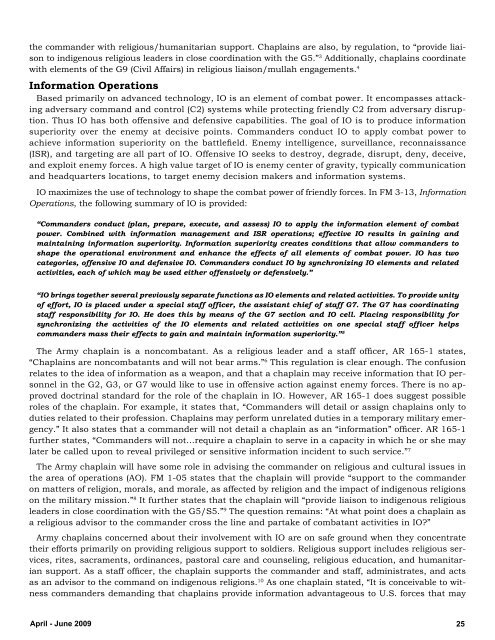Military Intelligence Professional Bulletin - Federation of American ...
Military Intelligence Professional Bulletin - Federation of American ...
Military Intelligence Professional Bulletin - Federation of American ...
You also want an ePaper? Increase the reach of your titles
YUMPU automatically turns print PDFs into web optimized ePapers that Google loves.
the commander with religious/humanitarian support. Chaplains are also, by regulation, to “provide liaison<br />
to indigenous religious leaders in close coordination with the G5.” 3 Additionally, chaplains coordinate<br />
with elements <strong>of</strong> the G9 (Civil Affairs) in religious liaison/mullah engagements. 4<br />
Information Operations<br />
Based primarily on advanced technology, IO is an element <strong>of</strong> combat power. It encompasses attacking<br />
adversary command and control (C2) systems while protecting friendly C2 from adversary disruption.<br />
Thus IO has both <strong>of</strong>fensive and defensive capabilities. The goal <strong>of</strong> IO is to produce information<br />
superiority over the enemy at decisive points. Commanders conduct IO to apply combat power to<br />
achieve information superiority on the battlefield. Enemy intelligence, surveillance, reconnaissance<br />
(ISR), and targeting are all part <strong>of</strong> IO. Offensive IO seeks to destroy, degrade, disrupt, deny, deceive,<br />
and exploit enemy forces. A high value target <strong>of</strong> IO is enemy center <strong>of</strong> gravity, typically communication<br />
and headquarters locations, to target enemy decision makers and information systems.<br />
IO maximizes the use <strong>of</strong> technology to shape the combat power <strong>of</strong> friendly forces. In FM 3-13, Information<br />
Operations, the following summary <strong>of</strong> IO is provided:<br />
“Commanders conduct (plan, prepare, execute, and assess) IO to apply the information element <strong>of</strong> combat<br />
power. Combined with information management and ISR operations; effective IO results in gaining and<br />
maintaining information superiority. Information superiority creates conditions that allow commanders to<br />
shape the operational environment and enhance the effects <strong>of</strong> all elements <strong>of</strong> combat power. IO has two<br />
categories, <strong>of</strong>fensive IO and defensive IO. Commanders conduct IO by synchronizing IO elements and related<br />
activities, each <strong>of</strong> which may be used either <strong>of</strong>fensively or defensively.”<br />
“IO brings together several previously separate functions as IO elements and related activities. To provide unity<br />
<strong>of</strong> effort, IO is placed under a special staff <strong>of</strong>ficer, the assistant chief <strong>of</strong> staff G7. The G7 has coordinating<br />
staff responsibility for IO. He does this by means <strong>of</strong> the G7 section and IO cell. Placing responsibility for<br />
synchronizing the activities <strong>of</strong> the IO elements and related activities on one special staff <strong>of</strong>ficer helps<br />
commanders mass their effects to gain and maintain information superiority.” 5<br />
The Army chaplain is a noncombatant. As a religious leader and a staff <strong>of</strong>ficer, AR 165-1 states,<br />
“Chaplains are noncombatants and will not bear arms.” 6 This regulation is clear enough. The confusion<br />
relates to the idea <strong>of</strong> information as a weapon, and that a chaplain may receive information that IO personnel<br />
in the G2, G3, or G7 would like to use in <strong>of</strong>fensive action against enemy forces. There is no approved<br />
doctrinal standard for the role <strong>of</strong> the chaplain in IO. However, AR 165-1 does suggest possible<br />
roles <strong>of</strong> the chaplain. For example, it states that, “Commanders will detail or assign chaplains only to<br />
duties related to their pr<strong>of</strong>ession. Chaplains may perform unrelated duties in a temporary military emergency.”<br />
It also states that a commander will not detail a chaplain as an “information” <strong>of</strong>ficer. AR 165-1<br />
further states, “Commanders will not…require a chaplain to serve in a capacity in which he or she may<br />
later be called upon to reveal privileged or sensitive information incident to such service.” 7<br />
The Army chaplain will have some role in advising the commander on religious and cultural issues in<br />
the area <strong>of</strong> operations (AO). FM 1-05 states that the chaplain will provide “support to the commander<br />
on matters <strong>of</strong> religion, morals, and morale, as affected by religion and the impact <strong>of</strong> indigenous religions<br />
on the military mission.” 8 It further states that the chaplain will “provide liaison to indigenous religious<br />
leaders in close coordination with the G5/S5.” 9 The question remains: “At what point does a chaplain as<br />
a religious advisor to the commander cross the line and partake <strong>of</strong> combatant activities in IO?”<br />
Army chaplains concerned about their involvement with IO are on safe ground when they concentrate<br />
their efforts primarily on providing religious support to soldiers. Religious support includes religious services,<br />
rites, sacraments, ordinances, pastoral care and counseling, religious education, and humanitarian<br />
support. As a staff <strong>of</strong>ficer, the chaplain supports the commander and staff, administrates, and acts<br />
as an advisor to the command on indigenous religions. 10 As one chaplain stated, “It is conceivable to witness<br />
commanders demanding that chaplains provide information advantageous to U.S. forces that may<br />
April - June 2009 25
















